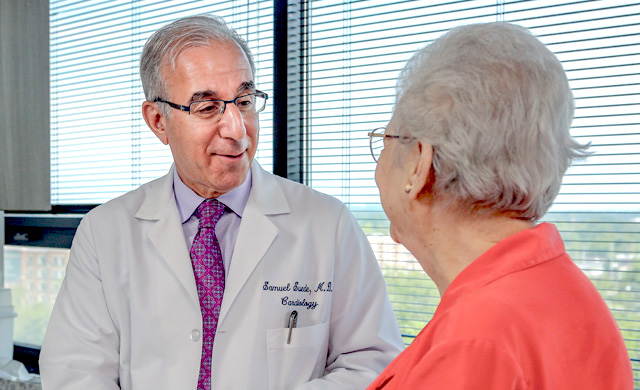
We start with a thorough cardiology history and examination. We assess a patient’s current cardiovascular condition and treat the issues of immediate concern. We also determine who is at risk for cardiovascular disease and design a preemptive plan to maintain a patient’s long term health.
For our patients with existing diseases and conditions, we use state-of-the art diagnostic testing and practice evidence-based medicine. Our experienced and highly trained staff is here to help each patient — from appointment scheduling to testing and follow-up care.
Cardiac Catheterization
Cardiac catheterization (or coronary angiogram) involves passing a thin flexible tube (catheter) into the right or left side of the heart, usually from the groin or the arm. The catheter is carefully threaded into the heart using an x-ray machine that produces real-time pictures (fluoroscopy).
A contrast agent or dye is inserted into the coronary arteries to diagnose any obstruction to blood flow. If a significant blockage is diagnosed, it may be fixed with a mesh tube called a stent that is placed through the artery without the need for surgery. Occasionally more extensive blockages are diagnosed that require coronary artery bypass surgery.
Carotid Ultrasound
A carotid ultrasound uses sound wave technology on your carotid artery (an artery in the neck) to check for narrowing or stenosis. The ultrasound helps to determine if plaque has built up in your artery walls. A narrow artery can lead to stroke.
Chest X-Ray
Chest x-rays are used to create an image of the heart, lungs and chest on film, in order to diagnose heart and lung diseases.
Echocardiogram
Also called an “echo,” this test is done to check how the valves and chambers of your heart are working. The test can also reveal the size of the heart and the thickness and movement of the heart wall.
During an echocardiogram, a health care provider — typically a radiographer or sonographer — uses ultrasound to create a moving picture of your heart. Echocardiograms are painless and noninvasive.
Transesophageal Echocardiogram
By passing a very small tube through your esophagus, we are able to see your heart’s activity through an ultrasound. This way, we can obtain very clear images of your heart to help diagnose certain disorders.
Electrocardiogram (EKG)
Often called an “EKG” or “ECG” for short, an electrocardiogram measures your heart’s electrical activity, including your heart’s rate and rhythm. The test can detect ischemia (lack of oxygen to the heart), heart attack, and a variety of other conditions.
During an EKG, a health care technician places sensors on your chest, arms, and legs. The sensors are connected to an electrocardiogram machine, which creates a three-dimensional map of your heart’s electrical rhythm. You simply lie still while the map is made; EKGs are painless and noninvasive.
Exercise Stress Test
During this test — sometimes known as a treadmill test, exercise cardiac stress test, or ECST — sensors are placed on your chest to record your heart as you exercise on a treadmill or stationary bike. Your heart rate, breathing, blood pressure, and electrical activity are monitored and recorded, along with any symptoms you may experience, to look for indications of coronary artery disease and angina (that chest pain caused by a shortage of oxygen reaching the heart muscle).
Holter Monitoring or Ambulatory EKG
We use this test to record your heart’s electrical activity throughout the day. Unlike a regular EKG, which shows your heart’s activity at one moment in time, an ambulatory EKG shows us how your heart functions over a longer period of time and while you’re going about your daily routine.
During the test you wear a Holter or mobile cardiac telemetry (MCT) monitor; these are portable devices with sensors that attach to your skin.
Home Telemetry Monitoring
Remote telemetry is a way to provide continuous monitoring of your heart. A small portable monitor is worn by placing 5 patches (electrodes) to the chest and the monitor fits into a pocket or worn on a belt loop. The electrodes pick up signals from your heart and your physician can see real-time data of your heart.
Nuclear Stress Test (Pharmacological Nuclear Stress Test)
In order to give us a better view of your cardiovascular system, a provider will deliver a small amount of radioactive dye into a vein for this test. Then a special camera detects the radiation and produces computer images of your heart that show blood flow.
Like an exercise stress test, this is a diagnostic tool that helps our physicians spot signs of heart conditions such as coronary artery disease (CAD).